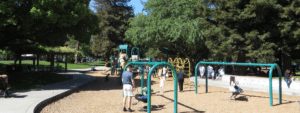Jennifer Wadsworth
After an hours-long public hearing, the San Ramon City Council unanimously OK’d the planning document amendments, one of which would expand the city’s urban growth boundary into the Tassajara Valley.
The City Council on Tuesday passed changes to San Ramon’s General Plan 2030 after an hours-long public hearing that drew dozens of opponents.
Most of the speakers addressed a controversial part of the document that would pull 1,600 acres of the Tassajara Valley into the city’s urban growth boundary. About 50 people attended the 5 p.m. meeting.
Environmentalist groups say that the move will lead to development in the rural valley east of the city, which is opposed by Greenbelt Alliance and Save Mt. Diablo.
Council members, however, said the heart of the issue is about control. If San Ramon leaves the boundary as is, Contra Costa County may determine what gets built there.
“It’s about placing control in the hands of San Ramon residents,” said Mayor Abram Wilson.
Having the land inside the city’s sphere of influence wouldn’t automatically pave the way for development. It would simply give San Ramon the authority to decide what gets built — or what gets protected from development.
Ultimately, the Local Agency Formation Commission has the authority to grant the city permission to allow building there.
For three years, plans have been in the works to build a 185-unit development called New Farm. Builder Tom Koch filed an application through the county in 2007 to place homes on one-acre parcels in the middle of olive orchards.
There is also an application filed to build a cemetery.
Environmentalists say to go ahead with those plans would violate the region’s rural zoning because a city infrastructure would be needed.
Some residents of the valley, like longtime local Dorothy Burt, said they also worry that the city hasn’t studied the traffic impacts of development east of Tassajara Road. She said she doesn’t trust San Ramon to protect the valley’s open space if it becomes part of the city’s domain.
Wilson said just because the city is trying to gain control of the area, it doesn’t necessarily mean the plan is to develop it, too. To build anything that’s not already allowed under its current zoning designation, there would have to be a separate document, called the Eastside Specific Plan, that would include its own set of public hearings and would require a ity council vote to pass.
The city is using Dougherty Valley as an example of poor planning and to explain why it’s trying to vote the land into city control. Councilwoman Carol Rowley said that if San Ramon residents had some say in how the dense subdivision was built, that there may have been more open space left in that area.
“This is not an easy task for us,” said Rowley, a 41-year San Ramon resident. “We want you to have a say with what happens where you live … we’re just saying, please let us help you plan this area.”
###
http://sanramon.patch.com/articles/council-agrees-to-place-updated-general-plan-on-november-ballot




